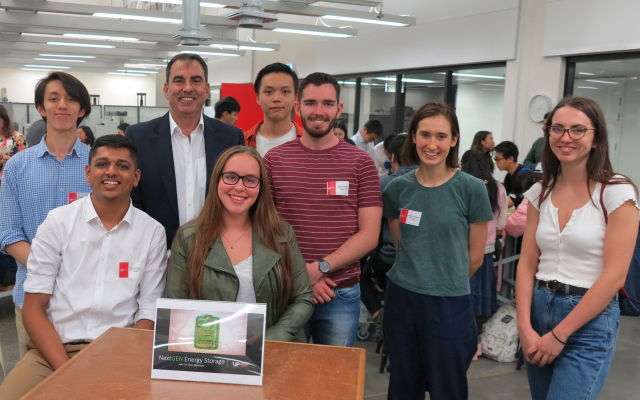
I powerwalk along Circular Quay in the sweet few weeks between Sydney being choked by smoke and locked down by COVID-19. Not even my impractical ballet flats or textbook-laden backpack can slow me getting to the International Coalition for Energy Storage and Innovation (ICESI) Conference 2020.
At the conference check-in, I am greeted by none other than Professor Maria Skyllas-Kazacos, the UNSW Emeritus Professor and inventor of the Vanadium Redox Flow Battery (VRFB). After fangirling internally, I am met by Associate Professor Chris Menictas – the academic lead for the NextGen Vertically Integrated Project (VIP).
Vertically Intergrated Projects (VIPs) are project-based courses led by academics with multidisciplinary teams of students ranging from 2nd year to PhD level.When the opportunity to work on a hands-on project, dip my toes in research and acquire course credits presented itself, I immediately applied. I was accepted into NextGen Energy Storage, a VIP focused on advancing both grid-level and lab-scale energy storage technologies. While our primary focus are VRFBs, we are also investigating technologies such as liquid metal batteries and hybrid flow batteries.
Chris gives me a sneak peek into the conference room where Professor Michael Stanley Whittingham (“Stan”) has “Zoomed-in” (surely it’s a verb now?) from the USA to give his keynote address. Two weeks prior, at oneof our first NextGen meetings, Chris casually mentioned that he was organising a conference with a presentation from a Nobel Laureate (!!!) and invited us all along. I jumped at the opportunity, eager to experience what a scientific conference was like, learn about the latest advances in energy storage technology and, being a uni student, score a free meal.
Having begun the VIP a mere three weeks prior, I felt WAY out of my depth at the conference. Stan’s speech, however, was a fantastic introduction to the history of energy storage technologies and future developments. Stan’s contribution to the field cannot be overstated. He is the “Founding Father” of rechargeable lithium batteries, which can now be found in devices from mobile phones and electric vehicles to grid-level batteries. Stan’s speech was insightful, examining the challenges faced by lithium batteries (explosion anyone?) and describing future works to advance the technology.
A common theme at the conferences was how vital energy storage technologies are in the transition to replacing fossil fuels with renewables. Energy storage technologies ensure energy when the sun doesn’t shine or the wind isn’t blowing and improve grid responsiveness and reliability. Some tense lunchtime discussions between academics exposed that not everyone agrees on which battery is up to this challenge.
As we look forward to a greener future based on renewable energy, the role of energy storage is crucial. I am grateful to be involved in NextGen at this critical time where developments in energy storage technologies have huge potential. I hope to contribute to the development of these transformative technologies and to push the boundaries of discovery thanks to the opportunity provided by the VIP program. Having spent our first term reviewing the literature, the team and I are eager to get into the lab and start experimenting.
